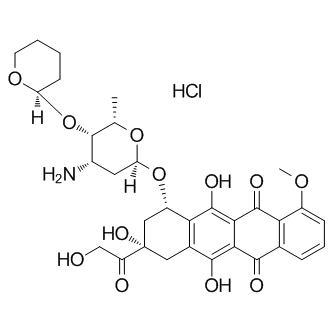| Description: |
Pirarubicin is an anthracycline antibiotics, acts as a topoisomerase II inhibitor, and is a widely used for treatment of various cancers, in particular, solid tumors. |
| Target: |
Topoisomerase II |
| In Vivo: |
Pirarubicin (18 mg/kg, i.v.) significantly elevates serum level of BNP, CK-MB, CTnT, LDH, and MDA compared with those in the control group in acute cardiac toxicity rats. Pirarubicin also lowers heart rate, and depresses R-wave voltage, and prolongation of QT intervals in the acute cardiac toxicity model[4]. |
| In Vitro: |
Pirarubicin is a topoisomerase II inhibitor[1]. Pirarubicin shows inhibitory activities against M5076 and Ehrlich cells, with IC50s of 0.366 and 0.078 μM, respectively. The cytotoxicity of Pirarubicin toward M5076 cells is lower than toward Ehrlich cells, and this is due to the much lower expression of topoisomerase II in M5076 cells than in Ehrlich cells[2]. Pirarubicin (2.5, 5, 10 μg/mL) significantly induces autophagy in a dose dependent manner in bladder cancer (T24, EJ, 5637, J82 and UM-UC-3) cells. Furthmore, Pirarubicin (5 μg/mL) induces apoptosis through inhibition of mTOR/p70S6K/4E-BP1 in bladder cancer cells, and this effect is enhanced by inhibition of autophagy[3]. |
| Cell Assay: |
MTS is used to analyze cell survival. Briefly, cells are plated in 96-well plates in triplicate at 2 × 103 cells per well and cultured in growth medium. Then cells are treated with pirarubicin at different concentrations (2.5 μg/mL, 5 μg/mL, 10 μg/mL) for 24 h. MTS reagent (5 mg/mL) is added and incubated at 37°C for 4 h. The absorbance is monitored at 490 nm using a microplate reader[3]. |
| Animal Administration: |
An acute cardiac toxicity model is established by a single dose of 18 mg/kg pirarubicin through the caudal vein injection. Thirty-six rats are randomized equally to six groups: normal control, cardiac injury (THP) model, dexrazoxane (180 mg/kg), low-dose rutin (25 mg/kg), middle-dose rutin (50 mg/kg), and high-dose rutin (100 mg/kg). Rats in the rutin-treated group are administered different doses of rutin and CMC-Na for 7 days by gavage and a single dose of 18 mg/kg pirarubicin through caudal vein injection. Rats in the dexrazoxane-treated group receive sodium carboxymethylcellulose (CMC-Na) by gavage for six days. 40 mg/kg dexrazoxane is then administered to rats by intraperitoneal injection and 18 mg/kg pirarubicin is administered by caudal vein injection on day 7. Rats in the THP model group receive CMC-Na by gavage for seven days, followed by pirarubicin 18 mg/kg through the caudal vein injection on day 7. Rats in the normal control group receive CMC-Na by gavage for seven days, followed by saline through caudal vein injection on day 7[4]. |
| References: |
[1]. Takigawa N, et al. Cytotoxic effect of topoisomerase II inhibitors against adriamycin- and etoposide-resistant small cell lung cancer sublines. Gan To Kagaku Ryoho. 1993 May;20(7):929-35.
[2]. Nagai K, et al. Relationships between the in vitro cytotoxicity and transport characteristics of pirarubicin and doxorubicin in M5076 ovarian sarcoma cells, and comparison with those in Ehrlich ascites carcinoma cells. Cancer Chemother Pharmacol. 2002 Mar;49(3):244-50. Epub 2002 Jan 8.
[3]. Li K, et al. Pirarubicin induces an autophagic cytoprotective response through suppression of the mammalian target of rapamycin signaling pathway in human bladder cancer cells. Biochem Biophys Res Commun. 2015 May 1;460(2):380-5.
[4]. Wang YD, et al. Cardioprotective effects of rutin in rats exposed to pirarubicin toxicity. J Asian Nat Prod Res. 2017 Oct 27:1-13. |






















